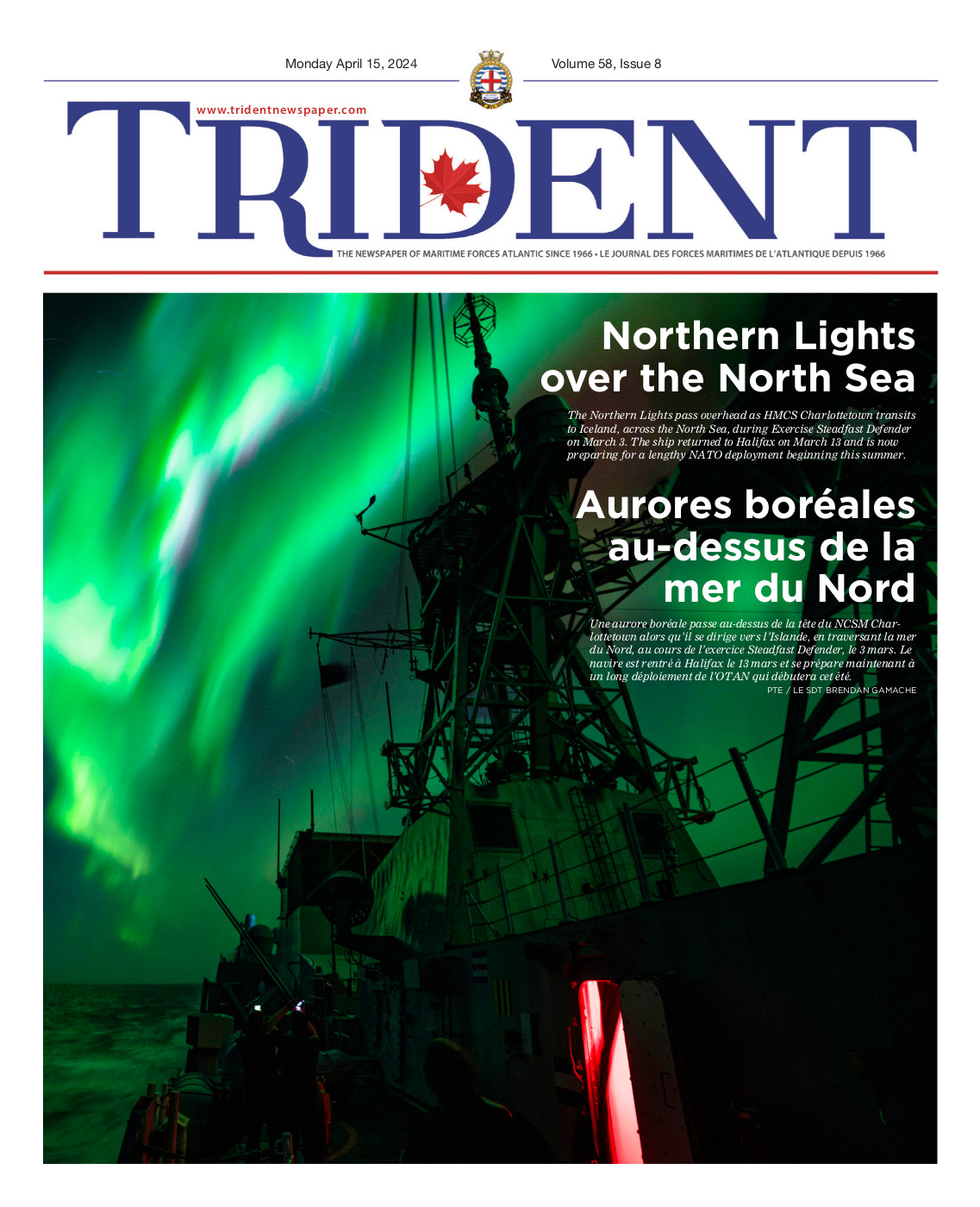
Photo: LS Dan Bard, FIS Halifax
HMCS Montréal honours fallen Second World War sailors
By Lt(N) Linda Coleman,
MARLANT Public Affairs
On September 18 and 19, 2017, HMCS Montréal took time from their operation to honour and remember the officers and sailors of HMCS Athabaskan who were lost at sea when the ship was torpedoed and sank off the coast of France on April 29, 1944 during the Second World War.
On September 18, the ship’s company, along with staff members from Canadian Fleet Atlantic embarked in HMCS Montréal for NEPTUNE TRIDENT 17-02, visited Plouescat Cemetery in France where 59 out of the 128 sailors from HMCS Athabaskan are buried. Wreaths were laid at the cenotaph by HMCS Montréal and Canadian Fleet Atlantic leadership. The next day, as the ship transited north as part of NEPTUNE TRIDENT, HMCS Montréal laid a wreath at sea over the area where HMCS Athabaskan sank. The wreath was laid by those who served in HMCS Athabaskan III, named after the original Athabaskan, whose members felt a close connection to the ship and its history.
The Commanding Officer of HMCS Montréal, Cdr Chris Sherban, made remarks during the ceremony that were raw and heartfelt. The remarks serve as a reminder of the horrors of war, the sacrifices made, and the importance of why we continue to remember our fallen heroes. Commander Sherban’s remarks are as follows:
Good Evening Montréal,
We are here not just to commemorate the loss of the Athabaskan, but to commemorate and honour the bravery and sacrifice of those officers and sailors who sailed on board her.
When I was at the cemetery yesterday, I was struck, as I usually am when I visit a war cemetery by the age of the fallen. Just imagine for a moment, you are here at this place, serving in the Athabaskan on that dark, cold morning in April. You’re in a fight with 2 Kriegsmarine torpedo boats 3 nautical miles off the coast, dangerously close to navigational hazards that could rip the bottom out of the ship at any moment. The noise would be deafening. Enemy rounds are impacting all around you, the wind and the boilers are roaring as you’re conducting tactical manoeuvres at speed, the forward and after batteries are firing salvo after salvo of 4.7 inch rounds at the enemy and with every round fired the concussions from the blasts are assailing every one of your senses. The only lights that you can see are the flashes from your guns and those of HMCS Haida’s and the enemy’s. Then, without warning, there is a tremendous explosion and you are catapulted into the air as the enemy torpedo finds it target. The ship shakes and heaves, many of the stokers who were below decks when the torpedo hit are already dead. Burning oil is all around you and as you still try to keep up the fire on the enemy ship, lights start to fade as the plant loses steam, damage control systems fail and you hear the frenetic shouts from the bridge to abandon ship and you jump into freezing water that is alight with burning bunker fuel. As you try to stay afloat you see the bodies and body parts of your shipmates float past you. You hear their screaming as they are being burned alive or are suffering from horrendous injuries and you are calling out for help, hoping against hope that somebody will find and save you.
Now imagine that you’re 18 – 20 years old – the same age as many of the sailors in the Athabaskan and indeed all of the fighting ships of the Navy. A year ago, you were finishing school, working on your family’s farm, trying to find a date for the next dance and suffering from all of that angst and awkwardness that sometimes afflict those who are young. Now you’re fighting for your life off a foreign coast wondering if you’re going to live or die. Imagine you at that age. It is easy to forget how young the crew was. The old man, the Captain, was only 31 years old!
These young men came from all parts of Canada and they fought a fierce battle with the enemy and many died on this spot 73 years ago. Walking amongst the tombstones yesterday at Plouescat and seeing all of the sailors who are still known only to god, the carnage and ferociousness of the battle is easily evident. There were many stories of bravery, courage and self-sacrifice that cold April morning. One of the stories that resonates with me the most is the story of the Captain, John Stubbs. Already in the water as his ship sank around him, the Haida spotted and approached him. HMCS Haida’s Captain, Harry DeWolf, implored Stubbs to come aboard, however he refused rescue, demanded that DeWolf take Haida back to England before they could be targeted by the Luftwaffe or returning Kriegsmarine units and then swam back to save as many of his sailors as possible. He died and is buried in Plouescat alongside those very same sailors. I only hope that if ever faced with a similar situation that I could find in myself the courage, poise and leadership that John Stubbs displayed that morning.
These are the qualities that we must strive to emulate and it is why we are paying homage to those that served in the Athabaskan. They bravely fought here, thousands of miles from their homes and loved ones and many died so that others may live free. I believe that it is our sacred duty to remember their sacrifice, bravery and courage. These are the ideals upon which the culture and fighting spirit of the Royal Canadian Navy were formed. They are the ideals that we must model as we continue to serve this great country of ours.






